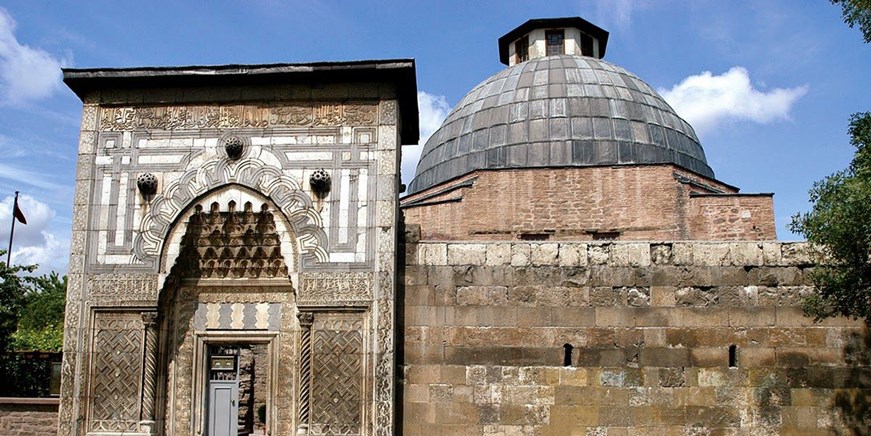Karatay Madrasa Konya: A Jewel of Seljuk Architecture and Learning

In the heart of Konya, Turkey, amidst the bustling streets and vibrant culture of this historic city, stands a testament to the rich legacy of Islamic education and architectural brilliance—the Karatay Madrasa. Built during the Seljuk period in the 13th century, this magnificent madrasa has served as a center for learning, scholarship, and spiritual enlightenment for over 700 years. From its exquisite tilework and intricate carvings to its serene courtyard and majestic dome, the Karatay Madrasa Konya continues to captivate visitors with its beauty and historical significance, offering a glimpse into the golden age of Islamic civilization.
Historical Context
The Karatay Madrasa was constructed in 1251 by the order of the Seljuk vizier Sahip Ata Fahrettin Ali, during the reign of Sultan Kayqubad I. It was named after the Karatay neighborhood where it is located, and it served as both a religious school and a place of worship for students of Islamic theology and law.
During its heyday, the madrasa attracted scholars and students from far and wide, who came to study under the guidance of renowned teachers and theologians. The madrasa played a pivotal role in the intellectual and cultural life of Konya, contributing to the flourishing of Islamic scholarship and the spread of knowledge throughout the region.
Architectural Marvels
The Karatay Madrasa is renowned for its stunning architectural design, which combines elements of Seljuk, Anatolian, and Persian styles. The exterior of the madrasa is adorned with intricate tilework and geometric patterns, while the interior features elaborately carved wooden ceilings, marble columns, and ornate mihrabs (prayer niches).
One of the most striking features of the Karatay Madrasa is its magnificent dome, which rises high above the central prayer hall and is adorned with colorful tiles and calligraphy. The dome serves as a symbol of divine majesty and spiritual enlightenment, inspiring awe and reverence in all who enter its hallowed halls.
Decorative Tilework
One of the highlights of the Karatay Madrasa is its exquisite tilework, which is considered some of the finest examples of Seljuk artistry in existence. The madrasa is adorned with vibrant tiles in shades of blue, turquoise, and green, depicting intricate floral motifs, geometric patterns, and Arabic calligraphy.
The tiles were crafted by master artisans using traditional techniques passed down through generations, and they reflect the sophistication and refinement of Seljuk ceramic art. Visitors to the madrasa can marvel at the beauty of these tiles as they wander through the corridors and chambers, soaking in the ambiance of this ancient center of learning and culture.
Preservation and Restoration
In recent years, efforts have been made to preserve and restore the Karatay Madrasa and its exquisite tilework, ensuring that future generations can continue to appreciate its architectural splendor and historical significance. Restoration projects have focused on repairing damaged tiles, stabilizing the structure, and improving visitor facilities to accommodate the growing number of tourists and scholars.
Additionally, the Karatay Madrasa has been nominated for inclusion on the UNESCO World Heritage List, recognizing its outstanding universal value and cultural significance. If successful, this designation would help to ensure the long-term protection and conservation of this remarkable architectural treasure, ensuring that it remains accessible to future generations for centuries to come.
Practical Information
- Location: The Karatay Madrasa is located in the heart of Konya’s city center, easily accessible by car, public transportation, or on foot.
- Hours: The madrasa is typically open to visitors daily, with varying hours of operation depending on the season. It’s advisable to check ahead for the latest opening times and any special events or closures.
- Admission: There is usually a nominal fee for admission to the madrasa, with discounts available for students, seniors, and groups. Tickets may also be purchased in advance online or at the madrasa’s ticket office.
In Conclusion
The Karatay Madrasa Konya is more than just a historic landmark; it’s a living testament to the enduring legacy of Islamic education and architectural brilliance. Whether you’re a scholar, a history buff, or simply an admirer of beauty and craftsmanship, a visit to this iconic madrasa offers a journey into the heart of Islamic culture and a deeper appreciation for the intellectual and artistic achievements of the Seljuk Empire. As the poet Rumi once said, “Let yourself be silently drawn by the strange pull of what you really love. It will not lead you astray.” And in the Karatay Madrasa, that pull is irresistible.




